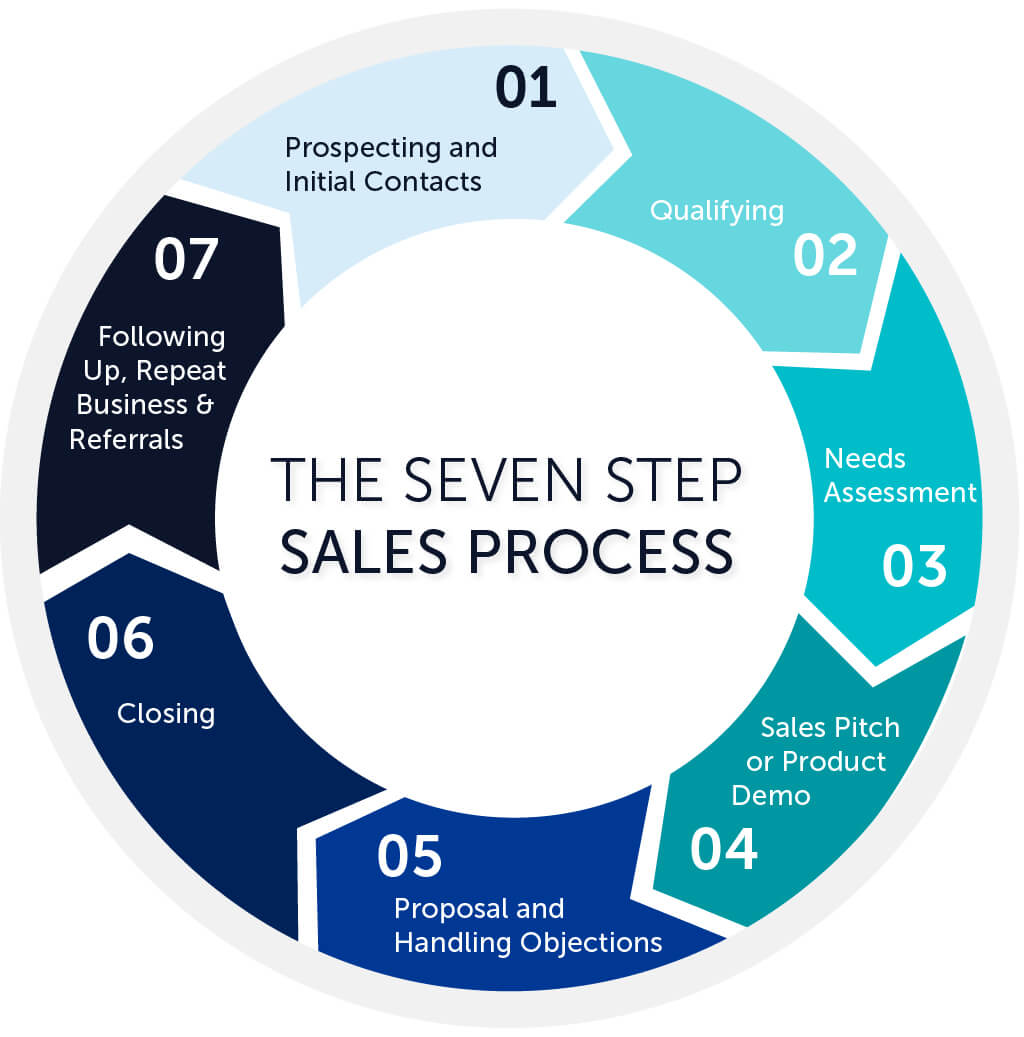With this article, we want B2B businesses to learn the right approach to build a scalable B2B sales process. Implementing sales processes can streamline any task, whether simple or complex. The benefits of processes in business apply to your sales department as well. Setting up B2B sales processes can make sales reps more effective, consistent, and precise both in their roles and in their customer interactions.
Sales reps who apply a sales process, increase their chances of success by being more effective in three vital areas:
- First, they have a better impact on clients and can find more potential customers, and know-how to influence them to drive them to a purchase decision.
- Secondly, they have greater skills that reflect in a higher closing rate
- Third, they developed time and task management techniques that allow them to invest more time in selling at the right time.
Without the support of a process, a seller can have difficulty managing the various elements of the sale. Here are some useful questions to verify the effectiveness of your sales process.
- Is equal attention given to each phase of the process or does over-focusing on one phase in particular lead to the exclusion of others?
- Is there sufficient and adequate market research to find and reach potential clients?
- Is enough and correct follow-up activity carried out after sending a quote?
- Are clients’ files updated regularly and continually during the negotiation progress and after each appointment with a client?
What is Sales Process
The sales process, often known as the sales cycle, is the way through which your organization sells your product or service to clients. It entails a sequence of processes, beginning with the initial contact with a lead and ending with the final sale.
The sales process is comparable to establishing a new connection. When you first meet, you get to know each other, find out what they enjoy, and figure out what their objectives are. You determine if you can work together and if you are a good fit along the way. If this is the case, the connection can continue to develop.
A sales process that complements your business, sales representatives, customers, and products or services will allow you to boost sales, close more deals and ensure that all of your reps are maintaining consistency in delivering a positive customer experience.
Why is Sales Process Important
Believing in your skills and resourcefulness is, of course, a great way to work, but sales is not a game of intuition and creativity. Sales is an organized series of tactical actions.
So, let’s talk about the reasons you need a standardized sales process.
1. Always Stay on Course
The sales process is often considered a sales rep’s roadmap. Following a roadmap is not about guiding sales reps to “do this, then do that.” Rather, a sales process with clear steps and objectives should act as a GPS. Understanding what each step entails helps sales reps understand where they are in the process, when it is time to move on to the next step and when to change their path.
2. Find the Cause of Stalled Sales
Adopting a sales process helps selling professionals determine the root cause of stalled sales. By following a set of steps, you will be able to evaluate whether your actions were effective or not, how many of them you needed, and what proved to be a failure or a waste of time.
If you follow a sales process, you can tell what you achieved and what you missed as well as how you achieved and how you missed it.
3. Improve Forecasting and Revenue
Getting a clear picture of where the sales reps are in the sales process helps managers make sales predictions more accurate. Since a process is a series of repeatable steps, it offers a clearer vision of how many deals the team closes from a given number of leads. This way you can forecast win rates and set quotas accurately.
4. Offer better a customer experience
Often a sales rep drives a customer through the next steps of a deal too soon, for which they may not be ready yet.
Not only does this harm the relationship, but it can also derail a deal. A well-designed B2B sales process that is customer-centric can turn a haphazard and sometimes pushy approach into a smooth customer experience.
Based on the buying behaviors and expectations of your client, a sales process will drive the actions that sell value, raise trust and build a deeper relationship with a potential buyer – all at the right time.
5. Constant Improvement in Sales Methods
Successful sales managers develop their sales processes based on observable results and continual feedback. For example, knowing where most of your deals are getting stuck or slipping away will help you recognize the root cause of those stalled deals and take action to address the problem.
Having a formalized sales process ensures the team focuses its attention on the biggest revenue-generating activities. Without a process in place, it’s hard to know which particular actions succeed or fail.
Building a scalable and effective sales process can be tough, especially because every business, sales team, and target audience is unique.
What Is a Sales Roadmap?
A sales roadmap, also known as a sales plan, is a high-level view of your company’s overall sales trajectory. It often includes sales targets, crucial deals, and important strategies that your sales team will use to generate revenue.
A sales roadmap zooms out from specific transactions and pipelines to display the overall picture of a complete sales organization, whereas sales agents focus on nurturing individual possibilities. Roadmaps are used by sales executives to convey their goals and strategies to other departments such as marketing, product, and operations.
Sales roadmaps are extremely useful for global sales teams since they demonstrate how diverse locations will collaborate to achieve organizational success. As sales teams develop and expand, a sales roadmap ensures that each team member is aligned with the organization’s larger goal, not just the sales department.
What Is Sales Process Flowchart?
A sales process is a systematic procedure including a number of phases that allow a sales team to close more transactions, increase earnings, and increase sales through referrals. It mostly consists of the stages listed below.
- Product understanding is a must before embarking on the sales process. When a person is well-versed in a certain product, he has a better chance of receiving more orders.
- Prospecting entails looking for possible clients who are in high demand. It is preferable to construct a customer database to store their information for future reference.
- Attempt to contact the possible buyer in a variety of methods. In general, a phone call is preferable to an email because many promotional emails end up in the rubbish folder.
- After calling a consumer, you should ask inquiries to ascertain his wants.
- After analyzing the customer’s demands, you can prepare a persuasive presentation.
- The final stage is to obtain a customer order.
The sales process flowchart seeks to simplify this complicated process by sketching various symbols and connectors.
So What Makes an Effective B2B Sales Process?
An effective sales process is:
Customer-centric
Buyers are more motivated to buy, are better educated, and have more possibilities than ever before. Successful companies are aligning their sales process based on changing customer buying behavior.
Clearly defined
To be successful, all stakeholders need to understand each stage and aspect of your sales process well.
Replicable
Every sales rep, without a doubt, should be able to duplicate all the steps in the selling process.
Predictable
In your sales process, the flow and expected results should follow a consistent pattern.
Goal-oriented
A sales process aims to enhance the ability to meet clear goals (for Example – drive revenue growth, achieve process efficiencies, and more).
Easy to calculate
All activities in your selling cycle should be quantifiable so that you can measure and enhance performance.
Adaptable
A selling process must be sufficiently flexible to meet a changing market environment, technical integrations, or changes in your sales operations.
Although most sales teams are aware of a general sales procedure, not all of them agree to outline and standardize a sales process. Businesses often leave it up to individual sales members to determine what steps to take and when.
7-Step Sales Process for B2B Businesses
- Preparation & Research
- Prospecting
- Need Assessment
- Pitch/Presentation
- Objection Handling
- Closing
- Follow-Ups, Repeat Business & Referrals

1. Preparation & Research
Preparation is the foundation upon which the sales process is built. Sales reps need to be familiar with their products/services, target audience, market, and the unique value their brand has. Study your competitors.
How can you add value to your product or service when your competitors are offering the same?
Take out some time and put yourself in your customer’s shoes. Prepare buyer personas. What are the primary challenges commonly faced by your buyers? And what are your solutions which can solve these problems? Brainstorm with your team to learn how your colleagues solve pain points, handle objections, close deals, and generate repeat business.
2. Prospecting
Finding customers is one thing. Engaging the best ones is a different matter. The sales prospecting process aims to qualify prospective customers who have demonstrated interest in your product or service, or who may be interested based on their profiles, business, or other characteristics.
Based on this benchmark, the sales and marketing departments will decide on an ideal customer profile and screen prospective clients. This helps the team to allocate resources to qualified, high-value leads accordingly.
Decide how you want to standardize the sales prospecting. There are various ways for your company to prospect such as through marketing methods, email marketing, sales intelligence tools, B2B data, networking at live events or trade shows as well as on social media, purchased lists, cold calling, and referrals.
Read About – Better Than Zoominfo
3. Needs Assessment
Now you have your potential customer’s attention. Fantastic! However, you also need to do the research to decide if they actually need what you are offering.
Sales reps need a set of standard questions prepared to ask prospects at this stage. A question set will keep reps asking for pertinent information and steer them away from dominating the conversation or assuming they know the answers. It also helps them look more professional before potential buyers.
Make sure that the interrogative questions are open-ended to facilitate a conversation. Reps need to be sure to listen more than they talk in the sales process at this stage. Though they may be tempted to be sales, they should not begin discussing offerings at this stage of the sales process.
Additionally, it helps them anticipate objections by knowing what could keep the potential client from moving toward your solution. You can include the following questions in this phase:
- What did you like or dislike about your previous provider?
- What business problem are you hoping we’ll be able to solve?
- Can you describe your current situation?
- Can you tell me how this situation will look when you’ve addressed your current business problem?

4. Pitch/Presentation
This is where you express the unique value that your customers will experience if they purchase your product or service.
You can drive a meaningful conversation by connecting their needs to the related features and advantages of your product. Sales reps must have a good understanding of what is being addressed during the needs assessment stage to create a successful sales pitch or presentation.
It is good to have additional information based on firmographic and technographic B2B data about the prospect’s company and industry during this stage. This additional information provides more background and helps you to create a customized sales pitch or demo of much higher quality.
5. Handling Objections
Once a sales rep presents a proposal/demo, the prospect often raises questions or concerns (ideally in your CRM).
Keep a record of these concerns, and what are the right approaches to answer them. Sharing this information with your sales team will ensure that your sales reps can respond to objections effectively and are ready with the most appropriate solutions to avoid any roadblocks to closing the deal.
Concerns and rejections are common in sales. Any salesperson that lacks strength and the ability to roll with the punches (objections) from prospects will struggle in this stage of the sales process. You need tough skin in sales and remember even a no is beneficial as it gives you feedback on what to focus on and improve.
To successfully handle complaints, practice empathy, and process the situation from the client’s point of view.
6. Closing
Usually, this stage of the 7-step selling cycle is where you finalize the deal, and all the efforts are reflected in the company’s revenue. While this may sound like the most crucial step, it is only effective if all the preceding steps are followed and accomplished successfully and in order.
This step commonly involves sending a proposal or a quote covering the tailored solution you are offering, prospects’ agreement to your terms, and price or negotiation for mutually beneficial terms. When all objections are addressed and all details are finalized for delivery, fulfillment, or related actions, then you can move to the final stage of the sales process.
Sometimes, after putting all of the effort to nurture an account to this stage, your prospects may ghost on you. They might not respond to your emails or phone calls. The best way to deal with this can be to reach out via additional channels, for instance connecting with them on their work mobile numbers.
7. Follow-Ups, Repeat Business, & Referrals
If you have successfully closed a deal, it opens up more opportunities for repeat business. Paying clients who are cross or upsold can be your most profitable source of revenue.
Satisfied customers make excellent candidates for your other services. By maintaining healthy client relationships, you can more effectively upsell and generate repeat sales.
A perfect way to maintain these relationships is by timely keeping your brand in front of your clients through product announcements, business insights, an e-newsletter, or an interactive loyalty plan.
Don’t be afraid to ask for referrals either. You have earned the account at this point!
How to Create a Sales Process
To establish a successful sales process:
- Analyze your sales funnel
- Convert activities of your pipeline into sales process stages
- Visualize your sales process
- Make each step measurable
Analyze the Sales Pipeline
Consider the customer journey and the nine steps of the sales pipeline before attempting to identify your company’s sales process. Then think about how each step fits into your company concept.
Alternatively, you may utilize your sales funnel to define the broader groups of actions that your team will need to do in order to nurture a lead through their customer journey.
Create a List of Internal Activities for Each Stage
The next step in building a sales process is to specify how each stage connects to your company and to define the sales activities that will take place inside each stage. Depending on what is required to finalize the deal, certain phases may include numerous actions while others may have only one. It’s also worth mentioning that certain stages may not have any internal activities if your company decides to outsource tasks in a stage.
Visualize Your Sales Process
Once you have developed your master list of tasks, you will want to examine which ones may be accomplished straight away and which ones require you to finish a previous activity first. One method is to visualize the process using flowcharts separated by shapes and colors that direct the observer down the path from beginning to end. This will also make training new sales reps on your sales process easier as your organization grows.
Make Each Step Measurable
Once each stage in the funnel has been outlined with essential actions and displayed in an easy-to-follow format for your sales team, the next step in creating a winning sales process is to discover ways to monitor the performance of each phase. To quantify your sales process, you may utilize a variety of metrics such as total values, conversion rates, and averages.
What is the Most Important Part of the Sales Process
The single most important part of a sales process is understanding your customer as closely as possible. This can be either questioning or having valuable data to nurture the lead further to the closing stage.
If the goal of selling is to solve your prospect’s issues or to assist him to make a purchasing decision, how can you do so if you don’t first try to comprehend his problem or uncover his requirements, and opportunities, and if the account is a good fit for your SQL criteria? That is the main goal of understanding your prospects and leads.
Sales reps should learn the art of effective question asking and prospecting as it leads to so many beneficial results, including:
- Prospect qualification
- To begin the relationship-building process
- Establishing credibility
- To establish and sustain trust
What Automatically Tracks All the Steps in the Sales Process
A CRM (Customer Relationship Management) system can automatically track all the steps in the sales process, from lead generation to conversion. It can help organize and prioritize leads, manage customer interactions, and provide insights into performance. A CRM can be customized to fit specific business needs and integrated with other tools for seamless data flow.
Why Your B2B Business Needs a Standardized Sales Process
A standardized sales process is essential for B2B businesses as it provides consistency, efficiency, and improved results. It ensures that sales teams follow a structured approach, enabling better tracking, analysis, and optimization of sales activities. Standardization promotes effective communication, streamlines workflows, and enhances collaboration within the organization. A standardized sales process helps identify bottlenecks, refine strategies, and deliver a consistent and positive experience to customers, ultimately driving higher conversion rates and revenue growth.
Why is Closing the Sale Important?
This is a no-brainer closing is the ultimate and most important step of your sales process. The end goal of creating a sales process is to generate revenue by closing a sale.
In most circumstances, the length of time it takes to seal the sale is determined mostly by the sort of solution being sold. As a result, a large customer will have in place a purchasing process that incorporates a group of decision-makers. When top executives, such as VPs or SVPs, get involved, the process might take days, weeks, or even months to complete.
In contrast, if you contact the principal decision-maker in a small business, you may clinch the transaction in a couple of minutes. As a result, it is critical to assess the decision-making process early in the qualifying process. Having a clear view of the expected length of the sales process may help salespeople stay motivated and make the correct movements at the right time.
Final Thoughts
We’ve outlined our preferred 7-step sales process. However, many organizations need a shorter 3 to 5 stage sales process, while some need a much longer process. Is this the one that suits your business? Whatever the stages your business may require, the important part is actually having a well-defined process that everyone understands and follows.
Want to handle the B2B selling like a pro?






